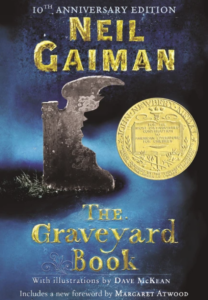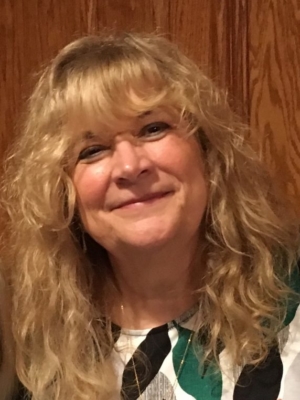Spinning Spooky Facts Into Fiction
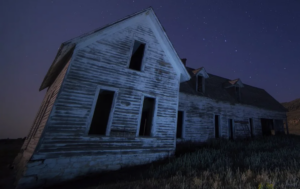
Photo Credit: Thomas Shellberg/Unsplash
Many years ago, when cops rarely arrested teenagers for trespassing in vacant buildings, I went ghost hunting with my forever friends, Marney and Janine. Our target was a building in an abandoned arsenal not far out of town. It was a moonless, windy night, perfect for a bit of misbehavior and mischief.
Troupes of orange and brown leaves twirled and danced around our ankles as we clambered over the chain-link fence. We ran through the chilly prestorm air toward the trees, our flashlight rays sweeping the darkness like luminous windshield wipers. We’d never been to the arsenal before, but we immediately recognized the decaying frame structure that other middle-schoolers had described. It slumped at the intersection of two narrow paths, its weathered, siding grey and moss-covered.
“Fred said to look for the broken window on that side,” Marney said, pointing to the right.
I’d practically begged her to come and she was already nervous. We both constantly frightened ourselves silly reading comics like Tales from the Crypt and novels like The Haunting of Hill House. I prided myself on being the braver of us two, though only by a smidgen. “Too bad he wouldn’t come with us.”
“He’s been here twice already,” Janine said. “Both times, he almost died of fright, or so he claimed.”
“Ha!” I said. “He’s probably lying. Just to scare us.” Fred loved practical jokes, especially if they made you yelp or jump.
Truth be told, so did I. Which is why at that second, I squeezed the Halloween squishable toy in my pocket. It made a moaning sound. “Ooooohh.”
Marney cried out and I bent over, laughing.
Janine slapped my back. “Come on, stop messing around,” she said.
At the broken window, I reached past the jagged glass, flipped the latch, and forced the frame open. I helped push Marney and Janine inside and they hauled me in. We choked on the foul, stagnant air. Our flashlights revealed cobwebs, empty beer bottles, and raunchy graffiti. In one corner, a rat lay stiff and half-decomposed, its long tail pointing accusingly at us.
As if on cue to intensify the mood, the skies opened up and a torrent of raindrops slammed against the siding and roof. Thunder rumbled in the distance.
I quietly memorized the scene because Marney and I wrote comics together, and I hoped tonight’s adventure would become the material for a good story. We liked to write scary stuff, but we tried to add humor. And I had a few more tricks up my sleeve. Like a fat, rubber spider.
The moment we moved into an adjoining room through an open doorway, a deafening bang resounded from elsewhere in the building.
We froze. My heart pounded so hard I thought it would crack my ribs. My flashlight blinked off.
“Gail, I swear—” Marney said, assuming I’d doused it to be funny.
Instead of answering, I linked my arm with hers.
“Maybe it was just thunder,” I said, willing myself believe it.
“Maybe we should leave,” Janine said. “It could be Fred. But if it’s not, we could be in danger.”
That’s right, I thought. No security guard—if the arsenal even had any—would bang on a wall. But it could be Fred. It probably was. I started to sweat.
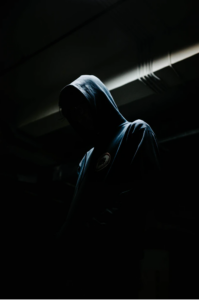
Photo Credit: Rendiansyah/Unsplash
Before we could act, a hooded, half-masked figure stepped out of the dark. Ebony eyes glowed in Marney’s and Janine’s flashlight beams.
I felt my and Marney’s bodies shaking. I was holding my breath, but she was breathing hard. “Ha-uh, ha-uh, ha-uh.”
The figure stood rigid, as if waiting. If it was Fred, our shocked expressions would have triggered his booming staccato laugh. Without warning, the figure popped open its mouth wide enough for an orange to slide inside. Eyes still illuminated, it unleashed a howl so loud my chest reverberated.
When my flashlight flicked back to life, so did I.
“Run,” I screamed.
And the three of us turned and fled into the tempestuous night.
* * *
I am a children’s/young adult fiction writer. My love for writing scary/horror stories and novels began when, as a child, I experienced picture books like Where the Wild Things Are and young reader books like Grimms’ Fairy Tales. The earliest story I remember writing was about the evil shadow man who my sisters said lived in our attic. Another story showcased the witch who us local kids believed inhabited an empty house on my street.
Back then, my forever friends and I ventured into that attic, and crawled through the basement window of that vacant house, because we had the Scooby-Doo, scaredy-cat, adventure-seeking mindset for finding and confronting ghosts, monsters, and other supernatural things. The stronger the fear, the greater the thrill.
Over the years, I developed a method for writing scary stories. I’d loosely assemble the material I wanted to use, determine my story purpose, and impose craftsmanship upon these two elements.
What is this “material”? It’s particular facts of life I’ve discovered, experienced, or imagined, along with the human sensibilities that accompany them (e.g., sentiments, impulses, instincts, inhibitions). I have to dig deep into my memory bank to capture the authentic—and often vulnerable—emotions of my younger self (i.e., the constant anxiety about “measuring up”). My purpose in scary stories is to make the readers feel something, like wonder or anticipation or fear, via their senses and emotions.
While I could utilize story material based on other people’s lives, or simply use my present imagination to make things up, I prefer to rely on and/or get inspiration from my childhood and teen experiences, like the ghost-hunting escapade at the arsenal.
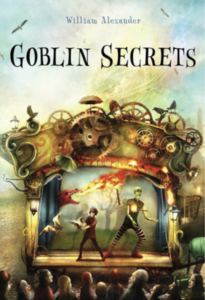
Margaret K. McElderry Books
Two of my favorite children’s/YA authors who write scary stories are William Alexander (he received the National Book Award for Goblin Secrets) and Neil Gaiman (his novel The Graveyard Book won the John Newbery Medal). Like me, their work has been inspired by their childhood memories. Alexander surmised that the first inkling for his NBA book came from bedtime stories read to him as a child, like The Princess and the Goblin. Ideas that arose from those stories were waiting in the back of his head when he started writing Goblin Secrets. Similarly, Gaiman said that in the case of his novel Coraline, he was inspired by a real door from his childhood that was bricked up, and he thought, “What would happen if one day, instead of opening onto a brick wall, there was a corridor?”
For me, it’s usually more than one childhood event that merges to supply my material. For example, when I began writing a middle-grade novel about twelve-year-old Albert, who was deathly afraid of storms until that fear was replaced by something even more terrifying (an angry phantom who began haunting him), the material I garnered came not just from my arsenal memories, but also from other ghostly experiences. Like Halloween excursions.
Every October, Marney, Janine and I identified the “haunted houses” that were opening for Halloween. There were several in the area—converted houses, barns, garages, buildings. Some were hokey (barely dark inside, ghosts and devils dressed in store-bought costumes).
But then there was the Maze of Mayhem that I both dreaded and anticipated visiting. Everything seemed so real that I swore actual ghouls were part of the ghastly performance—which featured apparitions that formed and faded, mobile mummies that smelled like death, and thirsty vampires that clacked their teeth.
My friends and I liked to go there late on Halloween night, when it was the most crowded. The parking lot teemed with teens waiting in line or milling around as they mustered up more courage.
The building’s rooms were pitch black and sectioned off to make thin passageways. Not only did the employees grab and scream at you as you passed by, but the customers screamed back, some for sport, and others from fright. People piled into each other as freaked-out attendees stopped dead in their tracks and others retreated partway through.
Although I always reminded myself as we entered the first dark corridor that this was all fake, my lily-livered brain forgot the moment we made the first turn and some creature struck or seized me.
The last time we attended, an especially creepy incident occurred:
“You go first,” Marney said to me.
“No you,” I said. “I went first last time.”
“Did not.”
“For crying out loud, I’ll go!” said Janine.
We had just paid our fee, and already the people in line behind us were pushing us toward the entrance door. For the millionth time, I wondered why I put myself through this torture.
We hadn’t gone ten feet into the passageway when something pulled my hair. “Aiiiieee!” I shrieked.
Janine, who was in front of me, was flapping her hands around, cursing up a storm.
As we continued, I heard water dripping and felt spider webs brush my face. Flashes of light revealed ogres and witches and goblins, some covered in blood—all of them flailing or grasping and screaming or moaning.
I stepped on something squashy and stumbled, falling onto Janine, bouncing off, and hitting the floor. I thought I’d be stomped to death. I began screeching like there was no tomorrow.
Arms reached out of the nothingness and pulled me under a black curtain, into a lightless void. “Shhhh,” a sinister shape whispered into my ear.
* * *
Once I have enough material to fuel my scary story, I fuse together the material and my purpose (the reader effect I’m striving for), using the best craft techniques I know. Alexander and Gaiman are both craft experts, especially when it comes to visual description. Here’s how Alexander paints the ghosts in A Properly Unhaunted Place:
“Figures moved through the fog. Long-limbed and towering things came striding by. Spirits made new clothes for themselves from dirt, leaves, and whatever else they found…Some were in pain and lashed out at the living. Others were made out of pain.”
And here’s how Gaiman characterized a ghost in The Graveyard Book:
“This: a raw, flickering, startling shape the grey color of television static, all panic and naked emotion…This creature was nothing but alarm and fear…little more than an outline, like distant summer lightning in the shape of a woman.”
These authors reach their readers through their senses, causing them to feel anxious, fearful. In my story about Albert, I wanted his first ghostly encounter to also impart those effects:
“Parting the rain, the cloaked figure strode toward me with spectral stealth. The wind threw back its hood and my eyes locked with sockets that bled black ink. A bleached, gnarled finger rose and pointed, and an inhuman voice hissed, ‘You!'”
American author Ralph Ellison said, “The act of writing requires a constant plunging back into the shadow of the past where time hovers ghostlike.” Alexander and Gaiman are plungers. Me too. Not only do my past memories linger ghostlike, but they’re also filled with frightening, ghostly experiences. I use these as material to craft a spooky narrative that I hope is compelling and vivid. Although I want to entertain my readers, my purpose is to saturate them with sensations: excitement, delight, alarm, fright, and—because I like happy endings—hope.
Fred never admitted that he was at the arsenal the night my friends and I ghost hunted there, but when we saw him at Dunkin’ Donuts after our narrow escape, he bellowed his staccato laugh the second he saw us. His clothes were soaked, as though he’d run through a massive rainstorm.
And as for that night at the Maze of Mayhem: After being dragged under the curtain, I was silently tugged through the building and out a back door. That shrouded “thing” murmured, “Wait,” and disappeared inside. Before my fear-frozen feet could move an inch, it was back, pressing a folded paper into my palm. When I read it later, it was a phone number. Real ghouls don’t write notes, do they?
Gail Vannelli writes primarily middle-grade and YA fiction. She has her MFA in Writing for Children and Young Adults from Vermont College of Fine Arts. She also has her Post-MFA Certificate in the Teaching of Creative Writing from Antioch University Los Angeles. She has won several Writer’s Digest awards for her fiction, and her more recent work has appeared in Lunch Ticket Literary Magazine, where she is an interviewer, blogger, and assistant editor, and in Cynsations, where she is an industry news reporter and writer.

